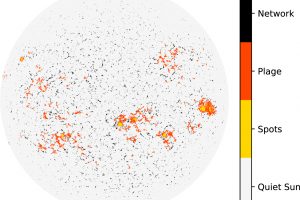The study: “Estimating Magnetic Filling Factors from Simultaneous Spectroscopy and Photometry: Disentangling Spots, Plage, and Network” of T. W. Milbourne (Harvard University), recently appeared on ApJ, present two new methods that allow astronomers to estimate the filling factor of magnetic active regions

About 20% of the exoplanets discovered so far (October 2021) were found with measurements of radial velocity (data from https://exoplanets.nasa.gov/). This method is based on spectroscopic observations of stars with planets, from which it is possible to measure the Doppler effect produced by periodic oscillations of the star, due to the gravitational attraction between star and planet along the orbit of the planet. It is intuitive that the intensity of the radial velocity signals depend on the mass ratio between star and planet: large planets orbiting around small stars produce larger radial velocity signals than small planets, such as Earth-like planets, orbiting around massive stars.
The limit of our capabilities in detecting small radial velocity signals is dictated mainly by phenomena related to the magnetic activity of the stars, such as spots, plage, and faculae. For instance, an Earth-like planet orbiting in the habitable zone of a Sun-like star (the habitable zone corresponds to the region where solid planets around a given star can host liquid water on their surfaces) produces a radial velocity signal of 10 cm/s, while the signal produced by the stellar magnetic activity is typically about 1 m/s.
The Sun is the only star in the Universe where we can resolve the magnetic active regions in the surface. The team of researchers led by the astronomer T. W. Milbourne (Harvard University and Harvard-Smithsonian Center for Astrophysics) analyzed observations of solar active regions with the aim of defining two methods which allow to estimate their filling factor and their contribution to the solar radial velocity signal. The observations were obtained from the solar telescope HARPS-N, which measures both spectroscopic features related to the chromospheric magnetic activity and the solar radial velocity signal, from the Total Irradiance Monitor detector mounted on the satellite SORCE (Solar Radiation and Climate Experiment), which produces time series of observations of the total solar irradiance, and from the instrument Helioseismic and Magnetic Imager onboard of the SDO (Solar Dynamics Observatory), providing direct measurements of the filling factor of the magnetic active regions. One of the two methods developed by the authors is based on the manipulation of time series of spectroscopic indices which measure the level of chromospheric activity (the S-index) and of the total solar irradiance. The second method, instead, is based on a neural network machine learning approach, trained on data of the solar magnetic activity. The two methods allow astronomers to estimate the filling factor of magnetic active regions and reduce the spread in radial velocity measurements due to magnetic activity of about 60%. The study is described in the paper: “Estimating Magnetic Filling Factors from Simultaneous Spectroscopy and Photometry: Disentangling Spots, Plage, and Network“, recently appeared on The Astrophysical Journal. The astronomer J. Maldonado of INAF – Astronomical Observatory of Palermo is one of the coauthors.
The figure (click here to visualize the entire image) shows a map of the active regions in the Sun (spots, plage, and faculae network) obtained with the Helioseismic and Magnetic Imager onboard on SDO.
Mario Giuseppe Guarcello ( follow mguarce) ( youtube)
Subscribe the Youtube channel of the Astronomical Observatory of Palermo
